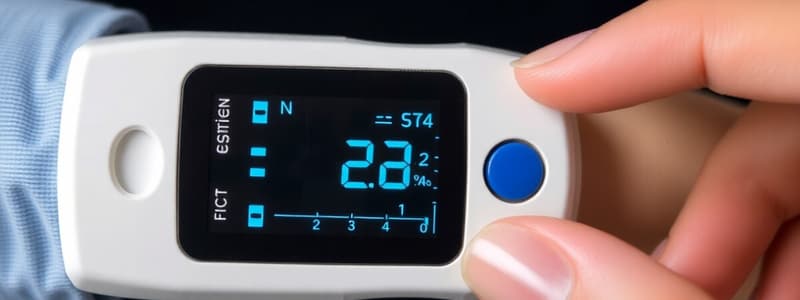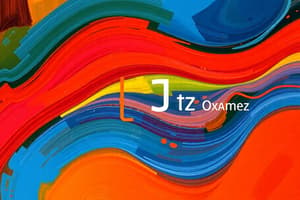Podcast
Questions and Answers
Oxygen saturation, as measured by pulse oximetry (SpO2), represents which of the following physiological parameters?
Oxygen saturation, as measured by pulse oximetry (SpO2), represents which of the following physiological parameters?
- The partial pressure of oxygen in arterial blood.
- The total oxygen content in the blood, including both dissolved and bound oxygen.
- The percentage of oxygen-saturated hemoglobin relative to total hemoglobin. (correct)
- The amount of oxygen dissolved in the plasma.
A patient's SpO2 reading is consistently below 90%. According to the provided content, which condition is indicated by this level?
A patient's SpO2 reading is consistently below 90%. According to the provided content, which condition is indicated by this level?
- Anemia
- Hypoxemia (correct)
- Hyperoxemia
- Normoxia
Which of the following conditions directly affects oxygen saturation levels by impairing the lungs' ability to fully expand?
Which of the following conditions directly affects oxygen saturation levels by impairing the lungs' ability to fully expand?
- Anemia
- Heart disease
- Collapsed lung (correct)
- Pulmonary embolism
Blood pressure (BP) is best described as which of the following?
Blood pressure (BP) is best described as which of the following?
Which factor could lead to a falsely elevated blood pressure reading?
Which factor could lead to a falsely elevated blood pressure reading?
According to the 2023 ESH guidelines for hypertension definition, what blood pressure reading is classified as hypertension?
According to the 2023 ESH guidelines for hypertension definition, what blood pressure reading is classified as hypertension?
A patient consistently presents with blood pressure readings below 90/60 mmHg. Which condition does this indicate?
A patient consistently presents with blood pressure readings below 90/60 mmHg. Which condition does this indicate?
In the context of blood pressure measurement, what is the purpose of palpating the radial pulse before inflating the cuff?
In the context of blood pressure measurement, what is the purpose of palpating the radial pulse before inflating the cuff?
Why is it important to wait for five minutes of rest before taking a patient's blood pressure?
Why is it important to wait for five minutes of rest before taking a patient's blood pressure?
During blood pressure measurement, at what anatomical position should the manometer be placed for optimal accuracy?
During blood pressure measurement, at what anatomical position should the manometer be placed for optimal accuracy?
Which of the following best explains the physiological basis of Korotkoff sounds?
Which of the following best explains the physiological basis of Korotkoff sounds?
Which of the following describes the correct placement of the cuff?
Which of the following describes the correct placement of the cuff?
What should be done immediately after determining the preliminary systolic pressure by palpation?
What should be done immediately after determining the preliminary systolic pressure by palpation?
Which action is essential when preparing a stethoscope for blood pressure auscultation?
Which action is essential when preparing a stethoscope for blood pressure auscultation?
Why is the diaphragm, rather than the bell, of the stethoscope typically used when measuring blood pressure?
Why is the diaphragm, rather than the bell, of the stethoscope typically used when measuring blood pressure?
According to the information, what is the recommended action if there is air trapped in the cuff before measuring blood pressure?
According to the information, what is the recommended action if there is air trapped in the cuff before measuring blood pressure?
After palpating the radial pulse, to what pressure level above the preliminary systolic reading should the cuff be inflated?
After palpating the radial pulse, to what pressure level above the preliminary systolic reading should the cuff be inflated?
Following a blood pressure measurement, what is the most important next step a healthcare provider should take?
Following a blood pressure measurement, what is the most important next step a healthcare provider should take?
Which arterial site is MOST commonly used for the auscultatory method of blood pressure measurement?
Which arterial site is MOST commonly used for the auscultatory method of blood pressure measurement?
Flashcards
Heart Rate (HR)
Heart Rate (HR)
The number of heartbeats per minute.
Oxygen Saturation (SpO2)
Oxygen Saturation (SpO2)
The percentage of hemoglobin saturated with oxygen in the blood.
Blood Pressure (BP)
Blood Pressure (BP)
Measurement of the force exerted by circulating blood on the walls of the blood vessels.
Respiratory Rate (RR)
Respiratory Rate (RR)
Signup and view all the flashcards
Body Temperature (BT)
Body Temperature (BT)
Signup and view all the flashcards
SpO2 (Peripheral Oxygen Saturation)
SpO2 (Peripheral Oxygen Saturation)
Signup and view all the flashcards
Oxygen Saturation Definition
Oxygen Saturation Definition
Signup and view all the flashcards
Blood Pressure (BP)
Blood Pressure (BP)
Signup and view all the flashcards
Blood Pressure Defined
Blood Pressure Defined
Signup and view all the flashcards
Sphygmomanometer
Sphygmomanometer
Signup and view all the flashcards
Aneroid Blood Pressure Monitor
Aneroid Blood Pressure Monitor
Signup and view all the flashcards
Electronic/Digital BP Monitor
Electronic/Digital BP Monitor
Signup and view all the flashcards
BP Measurement: Preparation
BP Measurement: Preparation
Signup and view all the flashcards
Stethoscope
Stethoscope
Signup and view all the flashcards
Preliminary Systolic Pressure
Preliminary Systolic Pressure
Signup and view all the flashcards
Cuff Inflation after Palpation
Cuff Inflation after Palpation
Signup and view all the flashcards
Korotkoff Sounds
Korotkoff Sounds
Signup and view all the flashcards
Normal Blood Pressure Reading
Normal Blood Pressure Reading
Signup and view all the flashcards
Hypotension
Hypotension
Signup and view all the flashcards
Potential causes for drop in BP
Potential causes for drop in BP
Signup and view all the flashcards
Study Notes
- Vital signs displayed include heart rate (HR), oxygen saturation (SpO2), non-invasive blood pressure (NIPB), respiratory rate (RR), and body temperature (BT).
- Typical values shown are HR 62 BPM, SpO2 99%, NIPB 102/67 mmHg, RR 22 RPM, and BT 36.6°C.
Oxygen Saturation
- Oxygen saturation has subtypes like venous oxygen saturation (SvO2), tissue oxygen saturation (StO2), and peripheral oxygen saturation (SpO2).
- Pulse oximetry device can be used to assess oxygen saturation by way of fingertip oximeter
Definition of O2 Saturation
- Oxygen saturation represents the fraction of oxygen-saturated hemoglobin relative to total hemoglobin (both unsaturated and saturated) in the blood.
- SpO2 = HbO2 / (HbO2 + Hb)
Normal Range of O2 Saturation
- Normal arterial blood oxygen saturation levels in humans range from 95-100%.
- Levels below 90% are considered low, or hypoxemia.
Conditions Affecting O2 Saturation
- Conditions like Chronic Obstructive Pulmonary Disease (COPD), asthma, heart disease, anemia, collapsed lung, pulmonary embolism, and congenital heart defects can impact oxygen saturation levels.
Blood Pressure Defined
- Blood pressure (BP) is the pressure or tension exerted on the arterial walls as blood pulsates through them.
Factors Affecting Blood Pressure
- Factors such as age, exercise, stress, race, genetics, food intake, obesity, smoking, alcohol consumption, and certain diseases can influence blood pressure.
Types of BP Measurement Tools
- Types of BP measurement tools include sphygmomanometers (with a calibrated glass tube containing mercury), aneroid devices (with a calibrated dial and needle), and electronic or digital devices (using a digital display and often including pulse rate).
Blood Pressure Cuff Sizes
- Blood pressure cuff size, you need to know arm circumference.
- 22-26 cm (8.7-10.2 in) arm circumference: 12 x 22 cm cuff (small adult)
- 27-34 cm (10.6-13.4 in) arm circumference: 16 x 30 cm cuff (adult)
- 35-44 cm (13.8-17.3 in) arm circumference: 16 x 36 cm cuff (large adult)
- 45-52 cm (17.7-20.5 in) arm circumference: 16 x 42 cm cuff (extra-large adult)
Pre-Procedure Steps
- Patients should rest for five minutes before blood pressure measurement.
- Measurements are typically taken with the patient seated (if ambulant), and either arm can be used.
- The patient's arm should be comfortably supported at about heart level.
Procedure Tips
- The arm should be exposed for BP readings.
- Check the cuff to ensure there is no air trapping
- Place the manometer at heart level
- Wrap cuff 2.5 cm above the antecubital area
Taking Measurements
- Ensure manometer is positioned straight & at eye level when taking measurements.
- Patient should sit in straight back chair, with arm resting on table
- Center of the cuff should be at heart level and patient should have feet flat on the floor.
- Palpate the radial pulse as the cuff is pumped. Pump until no pulse is felt to estimate preliminary systolic pressure.
- Completely deflate the cuff before proceeding.
Auscultation with Stethoscope
- The stethoscope's earpieces and diaphragm must be cleaned before use and ensure sounds are clear, not muffled.
- Parts of a stethoscope include eartips, binaural, binaural spring, tubing, bell, and diaphragm.
- Place the diaphragm over the brachial pulse.
- Inflate the cuff 20-30 mmHg above the previous preliminary systolic reading, and slowly deflate it while listening for systolic and diastolic sounds.
Systolic vs. Diastolic Reading
- The highest normal blood pressure reading is considered to be 120/80.
Korotkoff Sounds
- The phases of Korotkoff sounds that are heard when taking blood pressure:
- Phase 1: A sharp "thud" sound is heard
- Phase 2: A blowing or swishing sound
- Phase 3: A softer thud sound (softer than phase 1)
- Phase 4: A softer blowing sound that disappears
- Phase 5: Silence
Blood Pressure & Artery States
- No sounds are heard when the artery is closed
- Sounds can be heard as artery is opening and closing
- No sounds can be heard when artery is open
Factors Affecting Blood Pressure Readings
-
Some factors can decrease blood pressure readings:
- Cuff is too small 10-40 (mmHg)
- Cuff over clothing 10-40 (mmHg)
- Back/feet unsupported 5-15 (mmHg)
- Legs crossed 5-8 (mmHg)
- Not resting 3-5 minutes 10-20 (mmHg)
- Patient talking 10-15 (mmHg)
- Labored breathing 5-8 (mmHg)
- Full bladder 10-15 (mmHg)
- Pain 10-30 (mmHg)
- Arm above heart level 1.8/inch (mmHg)
-
Some factors can increase blood pressure readings:
- Arm below heart level 1.8/inch (mmHg)
Post-Procedure
- The blood pressure reading should be documented.
Hypertension Guidelines Comparison
-
Comparison of Hypertension Definitions; Normal and Hypertensive BP Ranges; and BP Targets for Treatment:
-
Guidelines for 2017 ACC/AHA:
- Hypertension Definition: ≥ 130/80
- Normal BP Ranges: Normal: < 120/80; Elevated: 120-129/<80
- Hypertensive BP Ranges: Hypertension Stage 1: 130-139/80-89; Hypertension Stage 2: ≥ 140/90
- BP Targets for Treatment:18 – 64 years (mmHg) : < 130/80; 65-79 years (mmHg): < 130/80; ≥ 80 years (mmHg) : < 130/80
-
Guidelines for 2023 ESH:
- Hypertension Definition: ≥ 140/90
- Normal BP Ranges: Optimal: < 120/80; Normal: 120-129/80-84; High-Normal: 130-139/85-89
- Hypertensive BP Ranges: Hypertension Grade 1: 140-159/90-99; Hypertension Grade 2: 160-179/100-109; Hypertension Grade 3: ≥ 180/110
- BP Targets for Treatment:18 – 64 years (mmHg) : < 130/80; 65-79 years (mmHg): < 140/80*; ≥ 80 years (mmHg) : 140-150/<80
Hypotension
- Hypotension is defined as blood pressure consistently below the normal range.
- Blood pressure of <90/60 mmHg is considered hypotension.
- May be caused by loss of blood; loss of vascular tone; or cardiac pumping problem
Studying That Suits You
Use AI to generate personalized quizzes and flashcards to suit your learning preferences.




